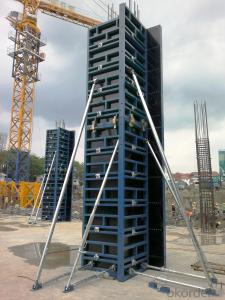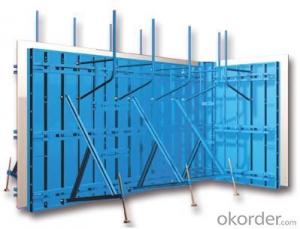Table Formwork system
- Loading Port:
- China Main Port
- Payment Terms:
- TT OR LC
- Min Order Qty:
- -
- Supply Capability:
- -
OKorder Service Pledge
Quality Product, Order Online Tracking, Timely Delivery
OKorder Financial Service
Credit Rating, Credit Services, Credit Purchasing
You Might Also Like
Tabel Formwork:
Table formwork is the most typical application for slab, with timber beam, the slab formwork is
light weight, fast and economic in the construction.
Characteristics:
◆ Simple structure, easy assembly.
◆ Flexible structure, be adapted to different support system.
◆ High construction efficiency with special system tools.
1. Lifting fork for lifting the table formwork to upper floor.
2. Trolley for moving the table formwork on floor.
◆ Flexible application with stand alone props.
◆ Safer condition with handrails.
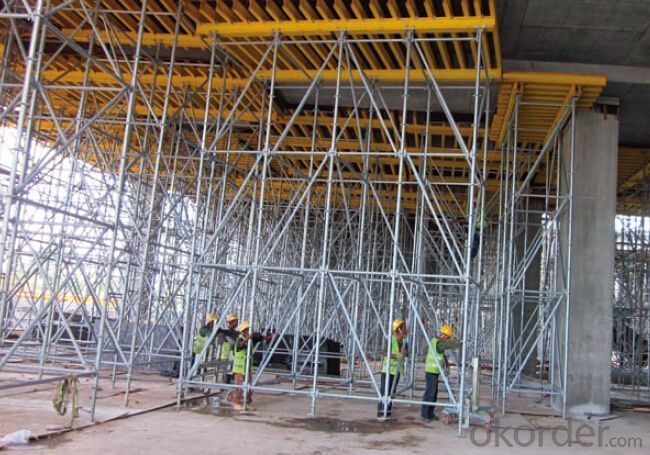
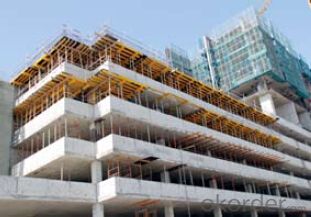
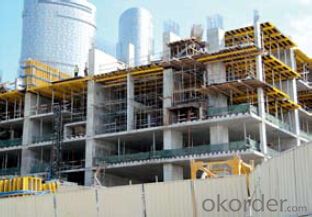
- Q:What are the safety precautions for transporting steel frame formwork?
- Some safety precautions for transporting steel frame formwork include securing the frames properly to prevent shifting or falling during transport, using appropriate lifting equipment and techniques to avoid injuries, ensuring that the load is within the weight capacity of the vehicle, and following all relevant transportation regulations and guidelines. It is also essential to inspect the formwork for any damages or defects before transportation to prevent accidents or structural failure.
- Q:What are the different types of formwork systems that can be used in conjunction with steel frame formwork?
- There are several different types of formwork systems that can be used in conjunction with steel frame formwork. These include: 1. Timber formwork: Timber formwork is one of the most commonly used formwork systems. It involves using timber boards or plywood to create the formwork structure. Timber formwork is versatile, cost-effective, and easy to work with. It is suitable for a wide range of concrete structures, including walls, columns, beams, and slabs. 2. Aluminum formwork: Aluminum formwork is a lightweight and durable formwork system. It consists of aluminum panels that are connected together to create the formwork structure. Aluminum formwork is known for its high strength-to-weight ratio, which allows for faster construction and reduced labor costs. It is commonly used for repetitive structures like residential buildings and commercial complexes. 3. Plastic formwork: Plastic formwork is a relatively newer formwork system that is gaining popularity due to its versatility and ease of use. It is made of lightweight and durable plastic panels that can be easily assembled and disassembled. Plastic formwork is suitable for a wide range of concrete structures, including walls, columns, and slabs. It offers advantages such as lower labor costs, reduced formwork waste, and improved construction speed. 4. Fiberglass formwork: Fiberglass formwork is a lightweight and high-strength formwork system. It is made of fiberglass panels that are capable of withstanding high concrete pressures. Fiberglass formwork is suitable for a variety of concrete structures, including walls, columns, beams, and slabs. It offers advantages such as easy handling, reduced labor costs, and improved construction speed. 5. Modular formwork: Modular formwork refers to a system where standardized formwork components are used to create various formwork configurations. It can be used in conjunction with steel frame formwork by integrating the steel frames with the modular formwork components. Modular formwork is highly flexible and can be adjusted to suit different construction requirements. It is suitable for complex structures and can be easily reused, making it a cost-effective option. Overall, these different types of formwork systems offer a range of advantages, such as versatility, cost-effectiveness, ease of use, and increased construction speed. The choice of formwork system will depend on factors such as the construction project's requirements, budget, and timeline.
- Q:Can steel frame formwork be used for retaining walls?
- Yes, steel frame formwork can be used for retaining walls. Steel frame formwork offers high strength and durability, making it suitable for constructing retaining walls that require structural support and can withstand heavy loads and lateral forces. The flexibility of steel frame formwork also allows for customization to accommodate various shapes and sizes of retaining walls.
- Q:Can steel frame formwork be used in cold weather conditions?
- Yes, it is possible to use steel frame formwork in cold weather conditions. Steel is well-known for its exceptional strength and durability, making it suitable for various weather conditions, including cold temperatures. However, certain precautions need to be taken when employing steel frame formwork in cold weather. To begin with, it is crucial to insulate the steel frame formwork adequately to prevent freezing. This can be achieved by utilizing insulation materials or adding a layer of protective material like tarpaulins. Insulation aids in maintaining the concrete's temperature during the curing process and prevents freezing, which can potentially weaken the structure. Furthermore, it is essential to ensure that the steel frame formwork is properly sealed to prevent the entry and freezing of any water. Water can expand when frozen, leading to potential damage to the formwork. Regular inspections and maintenance should be conducted to identify and rectify any potential leaks or cracks. Lastly, measures should be taken to shield the steel frame formwork from extremely cold temperatures. This may involve utilizing heaters or insulating blankets to maintain the desired temperature during the curing process. It is also crucial to adhere to the manufacturer's guidelines and recommendations regarding the usage of steel formwork in cold weather conditions. In conclusion, while steel frame formwork can be utilized in cold weather conditions, it is vital to implement proper insulation, sealing, and temperature control measures to ensure the structural integrity and durability of the formwork.
- Q:What are the different sizes and dimensions available for steel frame formwork?
- Steel frame formwork is available in various sizes and dimensions to cater to different construction requirements. The specific sizes and dimensions may vary based on the manufacturer and the specific project, but generally, they can be categorized into the following types: 1. Standard Panels: These are the most commonly used steel frame formwork panels and come in standard sizes such as 1.2m x 2.4m or 1.5m x 3.0m. The thickness of these panels typically ranges from 12mm to 18mm, depending on the load-bearing capacity required. 2. Large Panels: For larger structures or projects that require greater strength and stability, larger steel frame formwork panels are available. These panels can be as large as 2.0m x 3.0m or even bigger, with increased thicknesses ranging from 18mm to 25mm. 3. Adjustable Panels: To accommodate varying dimensions and complexities of construction projects, adjustable steel frame formwork panels are also available. These panels can be adjusted to different sizes and dimensions, allowing for greater flexibility and adaptability on the construction site. 4. Customizable Panels: Some manufacturers offer customizable steel frame formwork panels, which can be tailored to meet specific project requirements. These panels can be manufactured in non-standard sizes and dimensions to fit unique construction needs. In addition to the panel sizes, steel frame formwork systems may also include various accessories such as adjustable props, connectors, and clamps, which further enhance the versatility and functionality of the formwork. It is important to note that the availability of different sizes and dimensions may vary depending on the manufacturer and the region. Therefore, it is essential to consult with the specific supplier or manufacturer to determine the exact sizes and dimensions available for steel frame formwork.
- Q:How does steel frame formwork facilitate the construction of walls and columns?
- There are several ways in which steel frame formwork aids in the construction of walls and columns. Firstly, its high durability allows it to withstand the pressure exerted by wet concrete, enabling the creation of sturdy structures capable of supporting heavy loads. Secondly, the customizable nature of steel frame formwork allows for easy adjustment to different shapes and sizes. This adaptability facilitates the construction of walls and columns with intricate designs and varying dimensions. The formwork can be quickly assembled and disassembled, leading to efficient and cost-effective construction. Furthermore, steel frame formwork ensures excellent stability and alignment, guaranteeing accurate construction according to desired specifications. This precision is crucial for maintaining structural integrity and achieving a top-quality finish. Moreover, steel frame formwork's reusability makes it an environmentally friendly option for construction projects. After each use, the formwork can be cleaned, repaired, and stored for future use, reducing waste generation and minimizing expenses. To summarize, steel frame formwork is a valuable asset in the construction of walls and columns. Its durability, flexibility, stability, and reusability all contribute to an efficient and effective construction process, resulting in strong and well-constructed structures.
- Q:Are there any limitations to the number of pour cycles for steel frame formwork systems?
- The number of pour cycles for steel frame formwork systems has certain limitations that should be taken into account. To begin with, the overall durability of the formwork system can be affected by the number of pour cycles. As each pour cycle occurs, the formwork undergoes pressure and weight from the concrete, resulting in wear and tear over time. This repeated loading and unloading of the formwork can cause deformation, bending, or even cracking of the steel frames. Moreover, the quality of the concrete surface may be compromised after multiple pour cycles. Each pour cycle introduces the possibility of imperfections such as honeycombing, bug holes, or surface irregularities. These imperfections can accumulate with subsequent pour cycles, leading to a less smooth and visually appealing finish. Additionally, the process of stripping and re-assembly can become more time-consuming and labor-intensive as pour cycles increase. As the formwork system ages, its components may not fit together as tightly or securely, making it difficult to remove or align the formwork properly for the next pour. Consequently, this can slow down the construction process and increase the risk of errors or accidents. Furthermore, the load-bearing capacity of the formwork system may decrease over time. The repeated stress and strain from multiple pour cycles can gradually weaken the steel frames, reducing their ability to support the weight of the concrete. As a result, the safety of the structure may be compromised, necessitating more frequent inspections or reinforcement measures. In conclusion, while steel frame formwork systems offer advantages in terms of strength and reusability, it is important to recognize the limitations regarding the number of pour cycles they can effectively withstand. Considerations such as durability, concrete surface quality, ease of stripping and re-assembly, and load-bearing capacity can all be influenced as the formwork system ages. Therefore, careful planning is necessary to ensure the successful and safe completion of construction projects.
- Q:What are the key considerations for selecting the appropriate steel frame formwork system for complex structures?
- When selecting the appropriate steel frame formwork system for complex structures, there are several key considerations to keep in mind. First and foremost, it is important to assess the specific requirements and complexity of the structure. This includes factors such as the size, shape, and height of the structure, as well as any unique design features or challenges that may be present. Understanding the complexity of the structure will help determine the level of flexibility, adaptability, and customization required from the formwork system. Next, the load-bearing capabilities of the formwork system must be carefully evaluated. Complex structures often involve heavier loads and increased stresses, so it is crucial to select a steel frame formwork system that can handle the expected loads effectively and safely. This includes considering factors such as the strength, rigidity, and stability of the system. Another important consideration is the ease of assembly and disassembly of the formwork system. Complex structures often require intricate formwork configurations, so selecting a system that is easy to assemble and adjust will significantly improve productivity and efficiency on site. Additionally, the formwork system should have the capability to accommodate any necessary modifications or alterations during the construction process. The durability and lifespan of the formwork system should also be taken into account. Complex structures typically involve extended construction periods, so selecting a steel frame formwork system that is durable and can withstand prolonged use without compromising its structural integrity is essential. This includes considering factors such as the quality of materials, corrosion resistance, and maintenance requirements. Finally, cost-effectiveness is an important consideration. While complex structures may require specialized formwork systems, it is crucial to evaluate the cost-benefit ratio and select a system that offers the best value for money in terms of performance, durability, and productivity. In summary, when selecting the appropriate steel frame formwork system for complex structures, key considerations include assessing the complexity of the structure, evaluating load-bearing capabilities, considering ease of assembly and disassembly, ensuring durability and lifespan, and maintaining cost-effectiveness.
- Q:How does steel frame formwork handle the impact of vibrations during concrete pouring?
- Steel frame formwork effectively manages the vibrations caused by concrete pouring by utilizing a sturdy steel structure that offers exceptional strength and rigidity. This minimizes the impact of vibrations. Furthermore, the formwork is securely fastened to the ground or support structure, enhancing its stability. During the pouring of concrete, vibrations occur due to the pouring process itself and the use of vibrating equipment to eliminate air pockets and ensure proper compaction. These vibrations have the potential to destabilize or shift the formwork, which can compromise the integrity of the concrete structure. To counteract these vibrations, steel frame formwork often incorporates measures such as diagonal or cross-bracing. These additional supports reinforce the formwork system and distribute vibrations more evenly, reducing the concentration of forces on any particular point. In addition, steel frame formwork is typically designed with adjustable components, allowing for precise alignment and leveling during construction. This adjustability enables the formwork to absorb and adapt to vibrations, minimizing their impact on the concrete pouring process. Overall, the robustness and stability of steel frame formwork make it ideal for handling vibrations during concrete pouring. By providing a secure and rigid structure, along with additional bracing and adjustability, steel frame formwork ensures that the concrete structure remains uncompromised, resulting in a final product that is of high quality and durability.
- Q:How does steel frame formwork handle vertical and horizontal loads?
- Steel frame formwork has been specifically designed to effectively handle both vertical and horizontal loads. With regards to vertical loads, such as the weight of the concrete being poured, the steel frame formwork offers exceptional support and stability. The strong steel frame structure guarantees that the formwork can endure the pressure and weight of the concrete, avoiding any deformations or failures. Additionally, the formwork is typically reinforced with sturdy steel bars or mesh to further enhance its capacity to bear loads. Concerning horizontal loads, steel frame formwork is engineered to effectively resist lateral forces, such as wind or seismic loads. The steel frame structure provides the necessary rigidity and strength to counteract these forces and prevent any significant movements or displacements. Furthermore, the joints and connections between the steel members are meticulously designed and constructed to ensure proper transfer and distribution of loads, reducing the risk of failure under horizontal loads. In summary, steel frame formwork is designed to handle vertical and horizontal loads with utmost efficiency and reliability. Its strong structure, reinforced elements, and well-designed connections all contribute to its ability to support the weight of the concrete and resist lateral forces, resulting in a formwork system that is safe and durable.
1. Manufacturer Overview |
|
|---|---|
| Location | |
| Year Established | |
| Annual Output Value | |
| Main Markets | |
| Company Certifications | |
2. Manufacturer Certificates |
|
|---|---|
| a) Certification Name | |
| Range | |
| Reference | |
| Validity Period | |
3. Manufacturer Capability |
|
|---|---|
| a)Trade Capacity | |
| Nearest Port | |
| Export Percentage | |
| No.of Employees in Trade Department | |
| Language Spoken: | |
| b)Factory Information | |
| Factory Size: | |
| No. of Production Lines | |
| Contract Manufacturing | |
| Product Price Range | |
Send your message to us
Table Formwork system
- Loading Port:
- China Main Port
- Payment Terms:
- TT OR LC
- Min Order Qty:
- -
- Supply Capability:
- -
OKorder Service Pledge
Quality Product, Order Online Tracking, Timely Delivery
OKorder Financial Service
Credit Rating, Credit Services, Credit Purchasing
Similar products
New products
Hot products
Related keywords



















